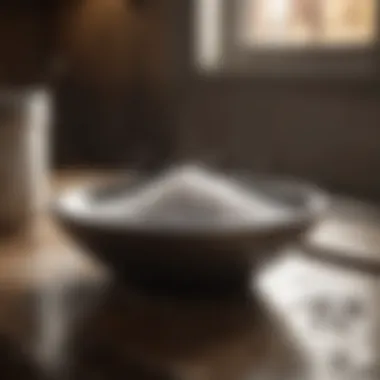Effective Household Items for Unclogging Drains


Intro
Clogged drains are a common household issue that can frustrate many homeowners. While many might turn to chemical cleaners or call a plumber at the first sign of trouble, there are effective household items that can be utilized to tackle these problems. Understanding how to use everyday items can not only resolve immediate drainage issues but also help in preventing future clogs. This article will delve into practical solutions that are accessible and cost-effective, enabling homeowners to maintain their plumbing systems without over-reliance on commercial products.
Every home has resources that can do wonders when it comes to clearing blocked drains. From baking soda to vinegar, these items may already be lying in your kitchen pantry. In this exploration, we will highlight key household items, their methods of application, and preventative measures to ensure lasting results. By mastering these techniques, you can efficiently manage your home's drainage systems with minimal fuss.
Understanding Clogged Drains
Clogged drains are a common issue in households, impacting both daily life and the overall functionality of plumbing systems. Recognizing the significance of understanding clogged drains is crucial for effective maintenance and preventative measures. Clogs not only disrupt the flow of water, but they can also lead to more severe plumbing problems and costly repairs if left unaddressed. Knowledge about the core aspects of drainage issues allows homeowners to respond swiftly and appropriately when faced with such challenges.
Common Causes of Clogs
Clogs can arise from various sources, and understanding these causes can aid in both prevention and remediation. Here are some common culprits:
- Hair: One of the most frequent contributors to clogged drains is hair. It can easily accumulate in shower drains and sink pipes.
- Food debris: In kitchen sinks, food particles can build up, particularly when there is a lack of proper disposal practices.
- Grease and oil: Pouring grease down the sink can solidify over time, leading to blockages.
- Soap residue: Bar soap and shampoo can leave residue that collects and restricts water flow.
- Foreign objects: Small items, such as toys or sanitary products, can accidentally be flushed and cause significant blockages.
Being aware of these common causes helps in implementing simple changes to reduce their impact and maintain clear drainage.
Signs of a Clogged Drain
Identifying the signs of a clogged drain early can save homeowners from further complications. Here are key indicators that suggest a drainage issue:
- Slow draining water: If water pools in sinks or tubs after usage, it's often the first sign of a clog.
- Unpleasant odors: Foul smells emanating from drains can indicate trapped food or organic matter.
- Gurgling sounds: Unusual noises when draining water can be a clear signal of a blockage.
- Water backup: In more severe cases, water may back up into appliances or floors, signaling a serious clog that requires immediate attention.
In summary, grasping the essential aspects of clogged drains enhances the proactive measures one can take, thus fostering healthier plumbing and preventing expensive reparations. Understanding causes and recognizing signs empower homeowners to maintain their household effectively, ensuring a trouble-free and efficient drainage system.
Essential Household Items
In addressing the challenges of clogged drains, understanding essential household items is of utmost importance. These items serve as practical solutions, often found within the confines of one's home, thus eliminating the need for harsh commercial products. Using everyday materials not only contributes to efficient clog removal but also promotes an eco-conscious mindset.
When selected and applied correctly, these items can prevent further issues down the line. They often possess unique properties that interact effectively with common clogging agents such as grease, hair, and soap residue. Moreover, utilizing these affordable household products makes drainage maintenance accessible to everyone.
Baking Soda
How it Works
Baking soda operates through a simple yet effective chemical reaction. Its alkaline nature allows it to dissolve organic material that frequently contributes to drain blockages. When it interacts with water, it froths, creating mini-bubbles. These bubbles help to break down grime and debris, enhancing flow through pipes. This method is not only beneficial but also popular, as baking soda is non-toxic, making it safe for household use.
The unique characteristic of baking soda lies in its versatility. It can be combined with other substances, such as vinegar, to escalate its unclogging power. However, it is less effective against very stubborn clogs, which may require additional methods for complete resolution.
Application Techniques
Effective application techniques for baking soda boost its unclogging capabilities. Often, one might start by pouring a cup of baking soda directly into the drain, followed by hot water. For enhanced outcomes, it is advisable to let the mixture sit for approximately 30 minutes before flushing with more water.
This method is noteworthy because it is straightforward and requires no extensive preparation. The only drawback is that it may not work immediately for severe blockages, which can lead to repeated applications. Despite this, it remains a user-friendly option for routine maintenance.
Vinegar
Chemical Reaction with Baking Soda
The chemical reaction between vinegar and baking soda is famed for its dramatic bubbling effect. When vinegar, an acid, combines with the base of baking soda, it creates carbon dioxide gas. This effervescence contributes to loosening debris within the drain.


This reaction is particularly beneficial for breaking down minor clogs formed from soap scum and organic matter. The unique aspect of this technique lies in its effectiveness without harmful chemicals, aligning with a safer cleaning practice. On the contrary, combining these two requires proper timing to avoid waste, as using them at once can limit the reaction's potential.
Effective Ratios for Use
To optimize unclogging, effective ratios during usage are crucial. The standard guideline is to use one cup of baking soda and one cup of vinegar. This combination yields maximum efficacy, leading to a significant release of gas that can push through blockages.
The key characteristic of this ratio is its simplicity, making it an excellent choice for everyday household issues. However, if the clog is particularly severe, adjusting these ratios might not suffice, thus requiring varying amounts or supplemental methods for best results.
Salt
Types of Salt
Salt can also aid in unclogging drains. It is essential to consider the types of salt available. Common table salt, coarse salt, and even Epsom salt possess different properties. Table salt can dissolve quickly and is easy to use, making it a practical choice for minor clogs.
The uniqueness of various salts lies in their solubility and texture. Coarse salt, for instance, has a scrubbing quality that may help with physical blockages, while Epsom salt may not be as effective due to its slower dissolution. Understanding these types can help in selecting the right salt for the job.
Preparation Methods
Preparation methods for salt can be straightforward. Typically, one might dissolve half a cup of salt in boiling water to enhance its effectiveness. This method proves essential as it helps to dissolve the salt evenly, preparing it for optimal action within the pipes.
The primary benefit of this preparation technique is its simplicity and ease of use. However, the downside is that salt may not entirely dissolve if it encounters too much cold water or solid food waste, rendering it less effective in certain scenarios.
Boiling Water
When to Use Boiling Water
Boiling water is a highly effective and immediate solution for clogged drains caused by grease and soap buildup. Hot water facilitates the melting of grease, allowing it to move through pipes more freely. This method is beneficial in fast removal of light to moderate clogs.
The primary characteristic of boiling water is its simplicity and instant action. However, it is essential to avoid using boiling water on PVC pipes, as high heat can damage them.
Best Practices
Best practices for utilizing boiling water include gradually pouring it down the drain in stages. Doing so allows the heat to work effectively on the blockage without overwhelming the pipes. Employing a kettle or pot for precision in pouring improves efficacy.
This approach is advantageous because it requires no special ingredients and is cost-effective. However, indiscriminate use can lead to issues with certain types of plumbing, which must be noted before usage.
Dish Soap
Grease Debris Reduction
Dish soap is particularly effective in reducing grease debris in clogged drains. Its surfactant properties help break down fats that typically cause stubborn clogs. This quality makes it a popular choice, as it can be found in most households.
The unique feature of dish soap is its ability to emulsify oils, aiding in their removal. This is beneficial for kitchens, where grease buildup is frequent, yet it may not work as efficiently on solid blockages caused by hair or food particles.
Combination with Hot Water
Combining dish soap with hot water amplifies its effectiveness against greasy clogs. By adding a few tablespoons of soap to boiling water, one can create a powerful solution that works through heavy grease and buildup.
This method is beneficial because it leverages two common household items. Yet, it is important to note that this solution may require multiple attempts for severe clogs, emphasizing the importance of patience and proper follow-up.
Advanced Techniques Using Household Items
Addressing a clogged drain often requires some advanced techniques alongside regular solutions. Utilizing everyday household items not only minimizes the need for harsh chemicals but also maximizes the effectiveness of your cleaning efforts. Through these methods, homeowners can achieve clearer drainage without the stress of plumbing bills or environmental repercussions.


Plunger
Choosing the Right Plunger
Selecting an appropriate plunger is crucial for effective drain unclogging. A cup plunger is best suited for sinks, while a flange plunger works well for toilets. The unique design of the flange plunger allows a better seal in the toilet bowl, providing more power when dislodging blockages. The key characteristic of the chosen plunger can dictate success in clearing a clog. This specific element ensures that the seal created is strong enough to generate the necessary suction. With the right plunger, the task becomes less strenuous, allowing for a more efficient drain clearing process.
Effective Techniques
Employing the right techniques when using a plunger can significantly enhance its effectiveness. Ensuring that there is enough water in the fixture is essential; too little water will prevent a good seal. It is beneficial to position the plunger head over the drain, applying firm pressure downwards and then pulling up quickly to create suction. This method is fundamental for dislodging stubborn clogs. Regular practice of this technique can make drain cleaning easier and is an efficient way to handle mild to moderate clogs.
Wet/Dry Vacuum
Setup Instructions
Setting up a wet/dry vacuum can be an invaluable skill when handling serious drain issues. Begin by selecting the appropriate attachment to fit over the drain opening. This ensures a tight seal for maximum suction. A key characteristic of the vacuum setup is the ability to handle both liquid and solid waste. Once you are ready, safely switch the vacuum on and allow it to run for several minutes. The unique feature of a wet/dry vacuum is its powerful motor, which can effectively pull debris and waste from the drain. Proper use of this device can save time and frustration during major clogs.
Tips for Maximum Efficacy
To maximize the efficacy of a wet/dry vacuum, timing and technique are important. Start with low suction settings to prevent backflow. If possible, create a vacuum seal around the opening of the drain to enhance suction. An additional tip is to use the vacuum immediately after noticing a clog. The sooner you tackle the problem, the better your chances of removing the blockage intact. This practice can greatly reduce potential damage to pipes, making it a proactive approach to drain maintenance.
"Proactive use of household items can transform the way drain management is approached, leading to more effective and environmentally-friendly solutions."
Preventative Measures
Maintaining clear drains is a crucial aspect of household management. Not only does it save time and effort in addressing clogs, but it also prevents potential damage to plumbing systems. Proactive measures ensure that drains function efficiently and contribute to overall home hygiene.
Regular Maintenance Routines
Implementing regular maintenance routines is vital for preventing clogs. These routines can vary based on household usage and the age of the plumbing. Here are some essential practices:
- Monthly Cleaning: Schedule a monthly deep cleaning of your drains. This can involve using a mixture of baking soda and vinegar to break down any potential buildup.
- Use Strainers: Place strainers over your sink and tub drains to catch hair and food particles. This simple action can significantly reduce the chance of clogs.
- Inspect and Clean: Regularly check and clean out any visible debris in drain traps. This includes removing hair from bathroom sinks and ensuring that kitchen sinks are free from grease accumulation.
Establishing these routines helps to identify issues before they escalate, ensuring a smoother drainage experience and reducing the likelihood of needing emergency interventions.
What Not to Flush
Understanding what not to flush is as critical as knowing how to maintain your drains. Certain items can cause immediate and severe blockages. Below are some items to always avoid flushing:
- Wipes: Even those labeled as "flushable" can cause significant clogs.
- Feminine Hygiene Products: These do not break down and can easily lead to blockages.
- Cotton Products: Cotton swabs, balls, and pads do not dissolve in water, hence should not be flushed.
- Grease and Oil: These substances solidify in pipes, leading to serious clogs.
Reminder: Always educate household members about drain safety, emphasizing the importance of avoiding flushing non-biodegradable materials.
By adopting these preventative measures, homeowners can minimize the risk of drain issues and maintain a healthy plumbing system. This proactive approach is beneficial not just for the immediate household but also for the long-term health of the plumbing infrastructure.
Long-term Drainage Solutions
In the context of maintaining a harmonious home environment, long-term drainage solutions can prove pivotal. It is not only about addressing immediate issues, but also about fostering sustainable practices to prevent future blockages. This section will delve into two main aspects: biodegradable drain cleaners and professional intervention, examining their roles and effectiveness in ensuring clear and functional drainage systems.
Biodegradable Drain Cleaners
To start with, biodegradable drain cleaners offer a plant-based alternative to conventional drain cleaning products. These cleaners are made from natural enzymes and bacterial cultures, supporting a safer environment both in the home and beyond. The significance of using biodegradable options lies in their ability to break down organic matter without causing harm to plumbing or the ecosystem. However, while they are generally safer, their effectiveness can vary compared to more potent chemicals.
Benefits and Drawbacks


The primary benefit of biodegradable drain cleaners is their environmentally friendly nature. They decompose naturally, reducing chemical exposure to your household and local water supplies. This characteristic makes them a popular choice among eco-conscious homeowners.
On the drawback side, biodegradability does not automatically imply that these cleaners are swift in their action. In some cases, homeowners may find that they require more time to work effectively compared to traditional chemical cleaners. A unique feature of biodegradable products is their gentleness on pipes, preventing corrosion over time, unlike harsher chemicals that can degrade plumbing materials.
Professional Intervention
Getting professional help is often necessary for serious drainage issues. Homeowners should recognize the time when DIY methods may not suffice. Seeking assistance allows for proper diagnosis and resolution of more complex problems that might not be apparent at first glance.
When to Seek Help
One key characteristic of professional intervention is the expertise brought by trained plumbers and technicians. If homeowners notice persistent clogs, unpleasant odors, or signs of water damage, these can be indicators that it’s time for professional help. Understanding the value of expert assistance becomes crucial in avoiding further complications that might worsen both the situation and the expenses involved.
Additionally, professionals have access to advanced equipment. This can include video camera inspections, which provide a clear view of blockages or damages within pipes that are not easily visible to the untrained eye.
Cost Considerations
Finally, understanding the cost implications is essential. Professional services can be perceived as expensive; however, they often save money in the long run by addressing issues before they escalate. One key aspect is the reassurance that comes with an expert service, guarding against mistakes that DIY attempts might introduce.
Unique to professional services, there are often varied pricing structures, depending on the severity of the issue and the type of work needed. While it may seem steep at first, mitigating potential issues through expert intervention can prevent costlier repairs down the line.
Overall, recognizing the importance of both biodegradable drain cleaners and professional help can greatly enhance the longevity and effectiveness of drainage systems.
Sustainability Considerations
Sustainability is an increasingly significant topic in everyday life, especially regarding household maintenance. Incorporating sustainable practices into drain unclogging solutions not only promotes environmental health but also minimizes reliance on potentially harmful chemicals. This section explores eco-friendly alternatives and highlights the importance of conscious decision-making in maintaining clear drains.
Eco-Friendly Alternatives
Many household items can serve as eco-friendly alternatives to commercial drain cleaners. These options are not only safer for the environment but are also often more cost-effective.
- Baking Soda and Vinegar: This classic combination is not only effective but also non-toxic. The fizzing reaction helps break down clogs without damaging pipes.
- Salt: Using salt in combination with boiling water can be effective. It serves as a gentle abrasive while being completely natural.
- Dish Soap: A bit of dish soap can help dissolve grease that accumulates in pipes. It is a simple and effective option.
These alternatives contribute to a sustainable lifestyle by reducing the need for harsh commercial chemicals that can disrupt ecosystems and cause other environmental issues.
Avoiding Harmful Chemicals
It is vital to avoid harmful chemicals in your drain maintenance routine. Many commercial products contain strong caustic substances that can pose risks to health as well as the environment. By choosing safer alternatives, homeowners can play a role in protecting both their homes and the planet.
- Risks of Harmful Chemicals: Many of these substances can cause skin irritation, respiratory issues, and create unpleasant fumes. Additionally, if they enter local water systems, they can disrupt aquatic life.
- Long-term Consequences: Using harsh chemicals can damage pipes and fixtures over time, leading to costly repairs.
- Encouraging Safe Practices: By promoting eco-friendly methods and ensuring safer alternatives are accessible, homeowners can help establish environmentally responsible habits.
"Using eco-friendly methods for unclogging drains supports a healthier home and planet. The choices we make today influence our future."
By prioritizing sustainability, not only can we effectively manage clogged drains, but we can also contribute positively to the environment, emphasizing the interconnectedness of our choices.
Closure
In evaluating the methods for addressing clogged drains, it is essential to recognize the cumulative benefits derived from household items. The versatility of these solutions not only supports effective drain clearing but also promotes sustainable practices. Homeowners gain both cost-savings and environmental advantages by avoiding harsh chemicals. This approach does not only foster a healthier living space but ensures that one's plumbing system remains in good condition.
Summary of Key Points
- Clogged drains stem from various factors, including grease buildup and foreign objects.
- Household items like baking soda, vinegar, and boiling water can combat these issues effectively.
- Knowledge of proper application techniques enhances the efficacy of these solutions.
- Regular maintenance and awareness of what not to flush mitigate the risk of future clogs.
Encouragement for Proactive Drain Care
It is vital to adopt proactive drain care habits. Regular checks and maintenance practices can prevent serious drainage problems before they escalate. Homeowners should take advantage of simple preventative measures, like using a drain cover and being mindful of waste disposal.
Ensuring a clear drain system not only improves household functionality but also contributes to a more sustainable lifestyle.
Taking these steps will yield benefits that extend beyond mere convenience, promoting the longevity of plumbing systems while protecting the environment.







